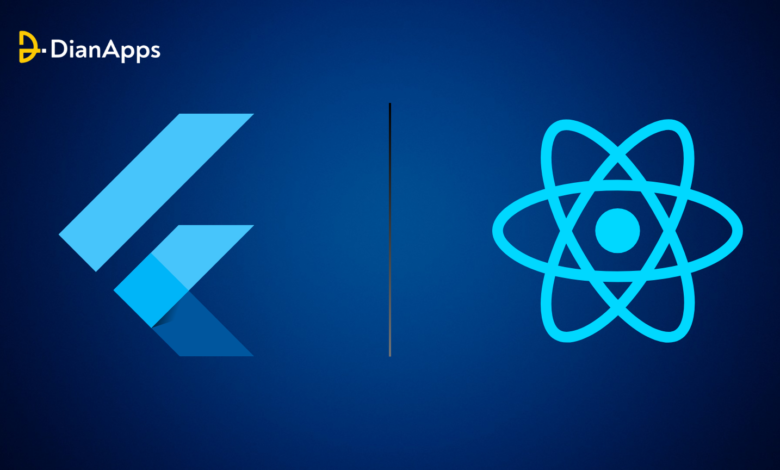Flutter vs. React Native: Which is Better for iOS App Development?

These days, having apps for both iOS and Android platforms is increasingly essential in mobile app market. However, separately developing for each can be time-consuming and costly. Hence, opting for cross-platform app development comes up as a practical solution.
Choosing between Flutter and React Native, the two leading frameworks, is crucial. While both offer valuable features and enjoy support from tech giants, understanding their workings and details is important for making an informed decision.
By examining the strengths and weaknesses of each, you can determine whether React or Flutter is the optimal choice for your iOS app project.
So, read the article till through the end to dig deeper into the details!
Evolution of React Native and Flutter
Flutter, introduced by Google in 2015, aimed to provide a framework for rendering apps seamlessly across various mobile platforms. Developed using Google’s programming language, Dart, Flutter released its preview version in 2017 and a stable version in 2018. Google continues to enhance Flutter by adding support for new APIs, facilitating better communication between apps and operating systems.
React Native, which evolved from Facebook’s need for a faster and more efficient app development solution in 2012, was officially launched in 2015. Its stable version followed in 2017. Leveraging JavaScript tools, React Native offers a robust rendering engine for building mobile app interfaces. Widely adopted by startups and development teams worldwide, React Native receives regular updates, fueling the creation of numerous SaaS businesses. Both frameworks remain popular choices for mobile app development, with Flutter focusing on its Dart-based approach and React Native on its JavaScript foundation.
Comparison – React Native Vs Flutter
- Ease of Learning
When developers contemplate between Flutter and React Native, they often ponder which language to learn. React Native, leveraging JavaScript, is perceived as easier due to its familiarity among developers, given its longstanding presence. In contrast, Flutter’s adoption of Dart may initially extend the learning curve. However, Dart’s incorporation doesn’t inherently complicate Flutter; rather, it’s a distinguishing aspect of Google’s platform, enhancing its capabilities and versatility.
- Community Support
In the field of cross-platform development, community support plays a crucial role. React Native, being established earlier, boasts a vast online community, ensuring easy access to solutions and assistance. However, despite its relative novelty, Flutter app development services are rapidly gaining momentum, with its community expanding consistently. Therefore, while React Native offers mature support, Flutter’s growing community indicates promising future assistance for developers.
- User Interface
React Native is more inclined towards native components for iOS and Android devices. It provides an extensive collection of external U-kits that help in developing beautiful user interfaces for your applications.
- Performance
Performance stands as an essential consideration in framework selection. While JavaScript-based frameworks address performance concerns, some, like React Native, rely on JavaScript bridges for hybrid app execution across platforms. In contrast, Flutter circumvents this by compiling directly to native code, bypassing the need for bridges. This distinction grants Flutter a performance edge over React Native, as it eliminates the overhead associated with JavaScript layers. Consequently, Flutter’s ability to reuse existing code without bridges enhances efficiency, positioning it favorably not only against React Native but also other cross-platform frameworks.
- Widgets and Third-Party Libraries
One major distinction between Flutter and React Native lies in their dependence on third-party libraries. Flutter, backed by Google, offers a rich set of built-in widgets and libraries, facilitating seamless development across Android and iOS platforms. While React Native calls for frequent integration of third-party libraries, potentially slowing down the development process. Moreover, Flutter’s comprehensive widget testing support streamlines testing procedures, unlike React Native, which often requires the adoption of external testing tools.
- Documentation Support
Given Google’s support, Flutter boasts extensive and detailed documentation, serving as a valuable resource for cross-platform developers. On the flip side, while React Native’s documentation is adequate, it tends to be more generalized and lacks the depth of Flutter’s resources. Additionally, React Native’s documentation can be disorganized, making it less user-friendly compared to Flutter’s well-structured guides.
- Industry Trends
In the StackOverflow survey of 2019, React Native garnered a significant approval rating of 62.5% among developers, primarily due to its established presence and utilization of familiar technologies like React and JavaScript. Consequently, React Native app development services offers abundant job prospects due to its widespread adoption. Conversely, Flutter, with a slightly higher approval rating of 65.4%, is relatively newer and less utilized by companies, resulting in fewer job opportunities presently, but this scenario could evolve in the future.
- Ease of Installation
React Native’s installation process is facilitated by Node Package Manager (NPM), streamlining the setup and making it relatively faster compared to Flutter. On the other hand, Flutter installation requires additional tasks, potentially making the process more complex and time-consuming for users.
- Development Time
Flutter’s extensive widget support contributes to shorter time-to-market for app development, but it requires skilled Dart programmers. React Native also enables rapid development, albeit with some dependency on native elements and JavaScript bridges, potentially extending the overall development time.
- CI/CD Support
Flutter’s CLI simplifies CI/CD setup, offering streamlined integration and delivery processes with minimal effort. In contrast, React Native lacks comprehensive guidance for CI/CD setup. Flutter’s CLI facilitates automated app deployment, ensuring smooth releases across various app stores for different mobile platforms. This robust support for CI/CD makes Flutter a preferred choice for cross-platform app development, addressing a crucial requirement efficiently.
React Native and Flutter in a nutshell
React Native
- Development time: 3-4 months
- Performance: Virtually indistinguishable from native performance
- Documentation: User-friendly, but not too extensive
- UI-creation: Has built-in native design components that work without lag
- Community support: 700 000 developers — the largest cross-platform framework in the world
- Minimal iOS and Android versions required to run the app: iOS 8 and Android 5.0, but can be an earlier version, at the expense of some features
- Code reusability: Reuse components shared by Android and iOS versions of the app
- Debugging: Has a debugging tool
- Backend integration: Can use Node.js which is also based on JavaScript code, so hiring developers makes the process easier
Flutter
- Development time: 4-5 months
- Performance: Close to native performance, has problems rendering animations
- Documentation: Decently structured
- UI-creation: Has widgets — “building blocks” which you can use to create an interface
- Community support: 138 000 stars on GitHub — a bit community
- Minimal iOS and Android versions required to run the app: iOS 8 and Android 5.0
- Code reusability: Can’t reuse components
- Debugging: Has a debugging tool
- Backend Integration: Can use AWS Amplify, so you’ll have to find a developer with relevant experience
When to Choose What?
Choose Flutter if your app requirements align with the following criteria:
- No requirement for native functionality
- Limited budget and tight project timeframe
- Quick app development and deployment
- Single codebase for multi-platform support
- High-performance requirement of 60-120 FPS
- Desire for a user-friendly, customizable UI with widgets
Choose React Native if your app requirements align with the following criteria:
- Need to scale existing project with cross-platform modules
- No restrictions on timeframe and budget
- Development of simple, lightweight native apps
- Creation of shared APIs out of the box
- Desire for asynchronous build and highly appealing UI
Final Words
In this article, the comparison between Flutter and React Native led to the conclusion that both frameworks work best in their areas. However, the choice should be based on your client’s requirements and target audience. So, if you are planning to have a team of experienced developers on board, who can help you deliver a project from scratch, contact a iOS app development company. These experts will help startups seeking to build a robust MVP or for projects requiring easy scalability.



